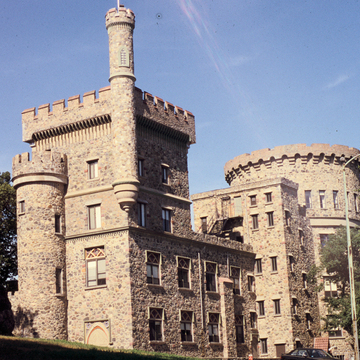One of the most important sites for the study of midcentury architectural modernism is the campus of Brandeis University. In 1948, Brandeis acquired its original ninety acres from the defunct Middlesex Medical College, along with a massive pseudomedieval building known as the Castle (1928–1940, NR), designed and built by the founder of the medical school, Dr. John Hall Smith. Located on a rugged hilltop at the eastern edge of the campus, the Castle is the only surviving building of the Middlesex campus.
The newly formed Brandeis Board of Trustees quickly selected internationally renowned architect and planner Eero Saarinen to develop a master plan. Saarinen's early plan located the academic buildings at the center of the campus, with dormitories and administration buildings on the periphery. Although Saarinen may have hoped for a larger role, his contribution was limited to the master plan and a few dormitories. In the 1950s, the New York firm of Harrison and Abramovitz developed a new plan for Brandeis's growth while maintaining Saarinen's idea of using red brick with limestone to harmonize with the New England environment. Throughout the 1950s and 1960s, major projects on campus were undertaken by a new generation of architects trained in the Bauhaus tradition—The Architects Collaborative, Ben Thompson, and Hugh Stubbins—who all made important contributions to midcentury modernism. Today, the campus has grown to more than 235 acres and stretches from the Charles River in the south to Route 128 in the north, with the towers of Boston visible nine miles to the east.















